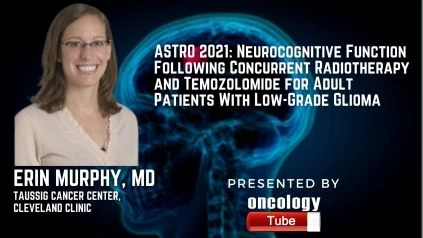Erin Murphy, MD Department of Radiation Oncology, Taussig Cancer Center, Cleveland Clinic speaks about ASTRO 2021 Abstract – 3258 Neurocognitive Function Following Concurrent Radiotherapy and Temozolomide for Adult Patients With Low-Grade Glioma.
Link to Abstract:
https://plan.core-apps.com/myastroapp2021/abstract/27f970a0-a161-48c6-adc4-064924c2d044
Case:
Goal:
RTOG 0424 showed that patients with high-risk low-grade glioma (LGG) who received concurrent temozolomide (TMZ) and radiation (RT) followed by adjuvant temozolomide (RT+TMZ) had a longer life than historical controls. The long-term effects of this therapy method on neurocognitive results are unknown. We wanted to see how neurocognitive parameters changed in adult LGG patients before and after RT+TMZ.
Components:
We looked at 22 LGG patients who had been treated with RT and TMZ after surgery. Pre- and post-treatment neurocognitive batteries were used. Learning and memory were measured verbally (Hopkins Verbal Learning Test [HVLT]) and nonverbally (Brief Visuospatial Memory Test [BVMT]), as well as motor functioning (Grooved Pegboard Test) and phonemic fluency (CFL). For paired samples, a nonparametric paired t-test (Wilcoxon signed ranked test) was used with post-treatments of within 3 months (14 pairs) and after 3 months (12 pairs). R 4.0.3 was used for all of the statistical analysis.
Findings:
The median age at diagnosis was 43 (range: 23-77), and 18 (82 percent) of the patients were men. IDHmut-1p19q-codel, IDHmut-1p19q-noncodel, IDHmut-NOS, IDH1-R132H-negative, and unknown were found in 3 (14%) patients, 1 (5%), 11 (50%) patients, and 4 (18%) patients, respectively, according to molecular classification. Three patients (14%) had a gross entire resection, two (9%) had a near total resection, six (27%) had a subtotal resection, and eleven (11%) had a biopsy (50 percent ). Within three months of undergoing RT+TMZ, patients showed no significant decline in nonverbal learning (BVMT total recall, P = 0.67, n=14) or verbal learning or memory (HVLT, P = 0.06, n=14). Nonverbal learning and verbal learning/memory, both tested > 3 months after treatment completion, showed no significant reduction (P = 0.62, n=12; P = 0.67, n=12). Within 3 months of treatment (P = 0.84, n=14; P = 0.26, n=14) and after 3 months (P = 0.94, n=12; P = 0.09, n=12), motor function (Grooved Pegboard, both dominant and non-dominant) remained steady. Within 3 months of treatment (P = 0.083, n=14) or after 3 months (P = 0.67, n=12), phonemic fluency (CFL) did not demonstrate a significant drop.
Outcome:
When compared to their pre-radiation baseline, adult LGG patients showed no subacute significant changes in verbal and nonverbal memory, motor function, or phonemic fluency after RT+TMZ. To determine the neurocognitive impact of this therapy method, bigger sample size and longer follow-up are required.

